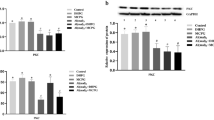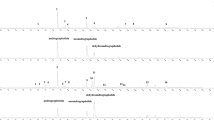Abstract
Aluminum neurotoxicity impairs learning and memory ability, but the molecular mechanism has not been elucidated. The aim of this study was to examine the role of phosphatidylinositol 3-kinase (PI3K)/Akt/mammalian target of rapamycin (mTOR) signaling in regulating the expression of synaptic plasticity-related proteins (PRPs) and p-tau deposition to explore the mechanism underlying aluminum-induced neurotoxicity. We constructed a sub-chronic aluminum-exposed Sprague Dawley (SD) rat model to assess aluminum neurotoxicity in vivo. The learning and memory abilities of rats were examined using the Morris water maze test. We also assessed the effect of aluminum in vitro using rat pheochromocytoma (PC12) cells. To explore the role of PI3K/Akt/mTOR signaling in aluminum neurotoxicity, we used the PI3K inhibitor wortmannin and the mTOR inhibitor rapamycin in aluminum-treated PC12 cells. Protein expression was examined by western blotting. Aluminum disrupted the learning and memory abilities of SD rats. Mechanistically, aluminum reduced the levels of the synaptic PRPs (cAMP-response element binding protein (CREB), glutamate receptor 1 (GluR1), glutamate receptor 2 (GluR2), and postsynaptic density protein 95 (PSD-95), and it increased p-tau deposition in the hippocampus of SD rats. We observed similar results in aluminum-treated PC12 cells. Further, PI3K/Akt/mTOR signaling was abnormally activated in aluminum-treated PC12 cells, and treatment with rapamycin reversed the decrease in synaptic PRPs levels and the increase in p-tau deposition. In conclusion, the activation of PI3K/Akt/mTOR signaling reduces the levels of synaptic PRPs and increases p-tau deposition induced by aluminum. Therefore, the PI3K/Akt/mTOR pathway participates in the mechanism of aluminum neurotoxicity.





Similar content being viewed by others
References
Baas PW, Qiang L (2019) Tau: it’s not what you think. Trends Cell Biol. https://doi.org/10.1016/j.tcb.2019.02.007
Bockaert J, Marin P (2015) mTOR in brain physiology and pathologies. Physiol Rev 95(4):1157–1187. https://doi.org/10.1152/physrev.00038.2014
Chai J, Wang Y, Li H, He W, Zou W, Zhou Y, Hu X, Chai Q (2016) Distribution of postsynaptic density protein 95 (PSD95) and synaptophysin during neuronal maturation. Xi Bao Yu Fen Zi Mian Yi Xue Za Zhi 32(12):1619–1622
Chiroma SM, Mohd Moklas MA, Mat Taib CN, Baharuldin MTH, Amon Z (2018) d-galactose and aluminium chloride induced rat model with cognitive impairments. Biomed Pharmacother 103:1602–1608. https://doi.org/10.1016/j.biopha.2018.04.152
Chong ZZ (2015) mTOR: a novel therapeutic target for diseases of multiple systems. Curr Drug Targets 16(10):1107–1132. https://doi.org/10.2174/1389450116666150408103448
Colomina MT, Peris-Sampedro F (2017) Aluminum and Alzheimer’s disease. Adv Neurobiol 18:183–197. https://doi.org/10.1007/978-3-319-60189-2_9
Ersahin T, Tuncbag N, Cetin-Atalay R (2015) The PI3K/AKT/mTOR interactive pathway. Mol Biosyst 11(7):1946–1954. https://doi.org/10.1039/c5mb00101c
Gabbouj S, Ryhanen S, Marttinen M, Wittrahm R, Takalo M, Kemppainen S, Martiskainen H, Tanila H, Haapasalo A, Hiltunen M, Natunen T (2019) Altered insulin signaling in Alzheimer’s disease brain - special emphasis on PI3K-Akt pathway. Front Neurosci 13:629. https://doi.org/10.3389/fnins.2019.00629
Graber TE, McCamphill PK, Sossin WS (2013) A recollection of mTOR signaling in learning and memory. Learn Mem 20(10):518–530. https://doi.org/10.1101/lm.027664.112
Huganir RL, Nicoll RA (2013) AMPARs and synaptic plasticity: the last 25 years. Neuron 80(3):704–717. https://doi.org/10.1016/j.neuron.2013.10.025
Johnson VJ, Sharma RP (2003) Aluminum disrupts the pro-inflammatory cytokine/neurotrophin balance in primary brain rotation-mediated aggregate cultures: possible role in neurodegeneration. Neurotoxicology 24(2):261–268. https://doi.org/10.1016/S0161-813X(02)00194-8
Leal G, Comprido D, Duarte CB (2014) BDNF-induced local protein synthesis and synaptic plasticity. Neuropharmacology 76(Pt C):639–656. https://doi.org/10.1016/j.neuropharm.2013.04.005
Li H, Xue X, Li L, Li Y, Wang Y, Huang T, Wang Y, Meng H, Pan B, Niu Q (2020) Aluminum-induced synaptic plasticity impairment via PI3K-Akt-mTOR signaling pathway. Neurotox Res 37(4):996–1008. https://doi.org/10.1007/s12640-020-00165-5
Liang RF, Li WQ, Wang XH, Zhang HF, Wang H, Wang JX, Zhang Y, Wan MT, Pan BL, Niu Q (2012) Aluminium-maltolate-induced impairment of learning, memory and hippocampal long-term potentiation in rats. Ind Health 50(5):428–436. https://doi.org/10.2486/indhealth.ms1330
Liu M, Sui D, Dexheimer T, Hovde S, Deng X, Wang KW, Lin HL, Chien HT, Kweon HK, Kuo NS, Ayoub CA, Jimenez-Harrison D, Andrews PC, Kwok R, Bochar DA, Kuret J, Fortin J, Tsay YG, Kuo MH (2020) Hyperphosphorylation renders tau prone to aggregate and to cause cell death. Mol Neurobiol 57(11):4704–4719. https://doi.org/10.1007/s12035-020-02034-w
Lu J, Gu L, Li Q, Wu N, Li H, Zhang X (2021) Andrographolide emeliorates maltol aluminium-induced neurotoxicity via regulating p62-mediated Keap1-Nrf2 pathways in PC12 cells. Pharm Biol 59(1):232–241. https://doi.org/10.1080/13880209.2021.1883678
M'Rad I, Jeljeli M, Rihane N, Hilber P, Sakly M, Amara S (2018) Aluminium oxide nanoparticles compromise spatial learning and memory performance in rats. EXCLI J 17:200–210. https://doi.org/10.17179/excli2017-1050
Mold MJ, O’Farrell A, Morris B, Exley C (2021) Aluminum and tau in neurofibrillary tangles in familial Alzheimer’s disease. J Alzheimers Dis Rep 5(1):283–294. https://doi.org/10.3233/ADR-210011
Mueed Z, Tandon P, Maurya SK, Deval R, Kamal MA, Poddar NK (2018) Tau and mTOR: the hotspots for multifarious diseases in Alzheimer’s development. Front Neurosci 12:1017. https://doi.org/10.3389/fnins.2018.01017
Nday CM, Drever BD, Salifoglou T, Platt B (2010) Aluminium interferes with hippocampal calcium signaling in a species-specific manner. J Inorg Biochem 104(9):919–927. https://doi.org/10.1016/j.jinorgbio.2010.04.010
O’Neill C (2013) PI3-kinase/Akt/mTOR signaling: impaired on/off switches in aging, cognitive decline and Alzheimer’s disease
Pan B, Li Y, Zhang J, Zhou Y, Li L, Xue X, Li H, Niu Q (2020) Role of mGluR 1 in synaptic plasticity impairment induced by maltol aluminium in rats. Environ Toxicol Pharmacol 78:103406. https://doi.org/10.1016/j.etap.2020.103406
Prvulovic D, Hampel H (2011) Amyloid β (Aβ) and phospho-tau (p-tau) as diagnostic biomarkers in Alzheimer’s disease. Clin Chem Lab Med. https://doi.org/10.1515/CCLM.2011.087
Querfurth H, Lee HK (2021) Mammalian/mechanistic target of rapamycin (mTOR) complexes in neurodegeneration. Mol Neurodegener 16(1):44. https://doi.org/10.1186/s13024-021-00428-5
Selkoe DJ, Hardy J (2016) The amyloid hypothesis of Alzheimer’s disease at 25 years. EMBO Mol Med 8(6):595–608. https://doi.org/10.15252/emmm.201606210
Shang N, Zhang P, Wang S, Chen J, Fan R, Chen J, Huang T, Wang Y, Duncan J, Zhang L, Niu Q, Zhang Q (2020) Aluminum-induced cognitive impairment and PI3K/Akt/mTOR signaling pathway involvement in occupational aluminum workers. Neurotox Res 38(2):344–358. https://doi.org/10.1007/s12640-020-00230-z
Shu Y, Zhang H, Kang T, Zhang JJ, Yang Y, Liu H, Zhang L (2013) PI3K/Akt signal pathway involved in the cognitive impairment caused by chronic cerebral hypoperfusion in rats. PLoS ONE 8(12):e81901. https://doi.org/10.1371/journal.pone.0081901
Skalny AV, Aschner M, Jiang Y, Gluhcheva YG, Tizabi Y, Lobinski R, Tinkov AA (2021) Molecular mechanisms of aluminum neurotoxicity: update on adverse effects and therapeutic strategies. Adv Neurotoxicol 5:1–34. https://doi.org/10.1016/bs.ant.2020.12.001
Song J, Gao T, Li W (2022) The palmitoylation/depalmitoylation cycle is involved in the inhibition of AMPA receptor trafficking induced by aluminum in vitro. Biol Trace Elem Res. https://doi.org/10.1007/s12011-022-03234-2
Spilman P, Podlutskaya N, Hart MJ, Debnath J, Gorostiza O, Bredesen D, Richardson A, Strong R, Galvan V (2010) Inhibition of mTOR by rapamycin abolishes cognitive deficits and reduces amyloid-beta levels in a mouse model of Alzheimer’s disease. PLoS ONE 5(4):e9979. https://doi.org/10.1371/journal.pone.0009979
Sui L, Wang J, Li BM (2008) Role of the phosphoinositide 3-kinase-Akt-mammalian target of the rapamycin signaling pathway in long-term potentiation and trace fear conditioning memory in rat medial prefrontal cortex. Learn Mem 15(10):762–776. https://doi.org/10.1101/lm.1067808
Tapia-Rojas C, Cabezas-Opazo F, Ca D (2019) It’s all about tau. Prog Neurobiol. https://doi.org/10.1016/j.pneurobio.2018.12.005
Tomljenovic L (2011) Aluminum and Alzheimer’s disease: after a century of controversy, is there a plausible link? J Alzheimers Dis. https://doi.org/10.3233/JAD-2010-101494
Wang H, Lu XT, Jia ZJ, Niu Q (2013) Effect of aluminum trichloride on abnormal phosphorylation of tau protein in SH-SY5Y cells. Zhonghua Lao Dong Wei Sheng Zhi Ye Bing Za Zhi 31(2):100–103
Wiatrak B, Kubis-Kubiak A, Piwowar A, Barg E (2020) PC12 cell line: cell types, coating of culture vessels, differentiation and other culture conditions. Cells. https://doi.org/10.3390/cells9040958
Wong M (2013) Mammalian target of rapamycin (mTOR) pathways in neurological diseases. Biomed J 36(2):40–50. https://doi.org/10.4103/2319-4170.110365
Xu Y, Zhang H, Pan B, Zhang S, Wang S, Niu Q (2018) Transcriptome-wide identification of differentially expressed genes and long non-coding RNAs in aluminum-treated rat hippocampus. Neurotox Res 34(2):220–232. https://doi.org/10.1007/s12640-018-9879-1
Funding
This work was supported by the National Natural Science Foundation of China NSCF (Grant number 81803208) and the Science Foundation Shanxi Province University (Grant number 2019L0997).
Author information
Authors and Affiliations
Contributions
Material was prepared by Guangheng Zhang and Yingying Zhao, experiments were performed by Yirong Xu and Yingying Zhao, and data collection and analysis were performed by Fan Bu and Yeping Zhang. The first draft of the manuscript was written by Yirong Xu, and all authors commented on previous versions of the manuscript. All authors have read and approved the final manuscript.
Corresponding author
Ethics declarations
Ethics Approval
All animal experimental protocols were approved by the Ethics Committee of Shanxi medical University Fenyang College.
Competing Interests
The authors declare no competing interests.
Additional information
Publisher's Note
Springer Nature remains neutral with regard to jurisdictional claims in published maps and institutional affiliations.
Rights and permissions
Springer Nature or its licensor holds exclusive rights to this article under a publishing agreement with the author(s) or other rightsholder(s); author self-archiving of the accepted manuscript version of this article is solely governed by the terms of such publishing agreement and applicable law.
About this article
Cite this article
Xu, Y., Zhang, G., Zhao, Y. et al. Activation of PI3k/Akt/mTOR Signaling Induces Deposition of p-tau to Promote Aluminum Neurotoxicity. Neurotox Res 40, 1516–1525 (2022). https://doi.org/10.1007/s12640-022-00573-9
Received:
Revised:
Accepted:
Published:
Issue Date:
DOI: https://doi.org/10.1007/s12640-022-00573-9




